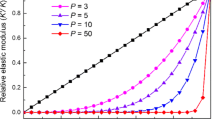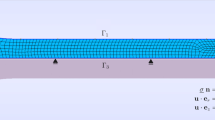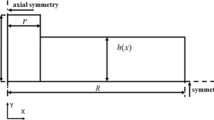Abstract
Flywheel energy storage systems (FESS) used in short-duration grid energy storage applications can help improve power quality, grid reliability, and robustness. Flywheels are mechanical devices that can store energy as the inertia of a rotating disk. The energy capacity of FESS rotors can be improved by choosing the optimal rotor geometry, operation conditions, rotor materials, and by tailoring the material properties. A multi-objective formulation is presented in this article to simultaneously improve the energy capacity and reduce the weight of energy storage flywheels using stress-constrained topology optimization to determine the material placement and optimize the stress distribution in the rotor. A Pareto-front of optimal solutions to the multi-objective problem demonstrates that the rotors with the best specific energy content have volume fractions of 55-65%. Local stress constraints with an Augmented Lagrangian formulation are introduced to improve the stress distribution and optimal design and are compared to designs obtained with global stress constraints based on P-norm aggregation approach. We show that designs with local stress constraints have a more uniform stress distribution and fewer stress concentrations compared to stress using P-norm.








Similar content being viewed by others
References
Amiryar ME, Pullen KR (2017) A review of flywheel energy storage system technologies and their applications. Appl Sci 7(3):286
Arani AK, Karami H, Gharehpetian G, Hejazi M (2017) Review of flywheel energy storage systems structures and applications in power systems and microgrids. Renew Sustain Energy Rev 69:9–18
Arghandeh R, Pipattanasomporn M, Rahman S (2012) Flywheel energy storage systems for ride-through applications in a facility microgrid. IEEE Trans Smart Grid 3(4):1955–1962
Arndt D, Bangerth W, Davydov D, Heister T, Heltai L, Kronbichler M, Maier M, Pelteret J-P, Turcksin B, Wells D (2017) The deal.II library, version 8.5. J Numer Math 25(3):137–146. https://doi.org/10.1515/jnma-2016-1045
Bruns TE, Tortorelli DA (2001) Topology optimization of non-linear elastic structures and compliant mechanisms. Comput Methods Appl Mech Eng 190(26–27):3443–3459
Cimuca GO, Saudemont C, Robyns B, Radulescu MM (2006) Control and performance evaluation of a flywheel energy-storage system associated to a variable-speed wind generator. IEEE Trans Industr Electron 53(4):1074–1085
da Silva GA, Aage N, Beck AT, Sigmund O (2021) Local versus global stress constraint strategies in topology optimization: a comparative study. Int J Numer Meth Eng 122(21):6003–6036
De Leon DM, Alexandersen J, Fonseca JSO, Sigmund O (2015) Stress-constrained topology optimization for compliant mechanism design. Struct Multidisc Optim 52(5):929–943
Duysinx P, Bendsøe MP (1998) Topology optimization of continuum structures with local stress constraints. Int J Numer Meth Eng 43(8):1453–1478
Duysinx P, Sigmund O (1998) New developments in handling stress constraints in optimal material distribution, In: 7th AIAA/USAF/NASA/ISSMO symposium on multidisciplinary analysis and optimization, p. 4906
Genta G (1985) The housing and vacuum system. Kinetic energy storage. Butterworth-Heinemann, Oxford, pp 169–200
Geuzaine C, Remacle J-F (2009) Gmsh: a 3-d finite element mesh generator with built-in pre-and post-processing facilities. Int J Numer Meth Eng 79(11):1309–1331
Giraldo-Londoño O, Paulino GH (2021) Polystress: a matlab implementation for local stress-constrained topology optimization using the augmented lagrangian method. Struct Multidisc Optim 63(4):2065–2097
GitHub (2022) jdumas/mma: A self-contained C++ implementation of MMA and GCMMA.—github.com, https://github.com/jdumas/mma, [Accessed 01-May-2022]
Hsieh B (1998) Transient analysis of a flywheel battery containment during a full rotor burst event., Tech. rep., Argonne National Lab., IL (US)
Jiang L, Wu C (2017) Topology optimization of energy storage flywheel. Struct Multidisc Optim 55(5):1917–1925
Kale V, Secanell M (2018) A comparative study between optimal metal and composite rotors for flywheel energy storage systems. Energy Rep 4:576–585
Kale V, Aage N, Secanell M (2023) Stress constrained topology optimization of energy storage flywheels using a specific energy formulation. J Energy Stor 61:106733
Le C, Norato J, Bruns T, Ha C, Tortorelli D (2010) Stress-based topology optimization for continua. Struct Multidisc Optim 41(4):605–620
Lottes LM, Kaiser N, Goossens N, Oelze HW, Braxmaier C (2021) Tomares-topology optimization of an additive manufactured reaction flywheel designed for an earth-observation satellite. CEAS Space J 6:1–2
Munro D, Groenwold A (2017) Local stress-constrained and slope-constrained sand topology optimisation. Int J Numer Meth Eng 110(5):420–439
París J, Navarrina F, Colominas I, Casteleiro M (2007) Global versus local statement of stress constraints in topology optimization of continuum structures. Trans Built Environ 1:13–23
París J, Navarrina F, Colominas I, Casteleiro M (2009) Topology optimization of continuum structures with local and global stress constraints. Struct Multidisc Optim 39(4):419–437
París J, Navarrina F, Colominas I, Casteleiro M (2010) Block aggregation of stress constraints in topology optimization of structures. Adv Eng Softw 41(3):433–441
Pereira JT, Fancello EA, Barcellos C (2004) Topology optimization of continuum structures with material failure constraints. Struct Multidisc Optim 26:50–66
Samineni S, Johnson BK, Hess HL, Law JD (2006) Modeling and analysis of a flywheel energy storage system for voltage sag correction. IEEE Trans Ind Appl 42(1):42–52
Sarasúa JI, Martínez-Lucas G, Lafoz M (2019) Analysis of alternative frequency control schemes for increasing renewable energy penetration in El Hierro island power system. Int J Electr Power Energy Syst 113:807–823
Sebastián R, Peña-Alzola R (2015) Control and simulation of a flywheel energy storage for a wind diesel power system. In J Electr Power Energy Syst 64:1049–1056
Secanell M, Putz A, Wardlaw P, Zingan V, Bhaiya M, Moore M, Zhou J, Balen C, Domican K (2014) Openfcst: an open-source mathematical modelling software for polymer electrolyte fuel cells. ECS Trans 64(3):655–680
Sigmund O (2007) Morphology-based black and white filters for topology optimization. Struct Multidisc Optim 33(4–5):401–424
Suzuki Y, Koyanagi A, Kobayashi M, Shimada R (2005) Novel applications of the flywheel energy storage system. Energy 30(11–12):2128–2143
Svanberg K (1987) The method of moving asymptotes-a new method for structural optimization. Int J Numer Meth Eng 24(2):359–373
Tsai T, Cheng C (2012) Topology optimization of flywheel rotors using simp method: a preliminary study. Adv Mater Res 579:427–434
Wang F, Lazarov BS, Sigmund O (2011) On projection methods, convergence and robust formulations in topology optimization. Struct Multidisc Optim 43(6):767–784
Yang R, Chen C (1996) Stress-based topology optimization. Struct Optim 12(2):98–105
Acknowledgements
The authors acknowledge the Natural Sciences and Engineering Research Council of Canada Energy Storage Technology (NEST) Network and Discovery grant to Prof. Secanell for financial assistance, and Compute Canada (http://www.computecanada.ca) and Westgrid (http://www.westgrid.ca) for support and access to high-performance computing resources. Niels Aage would like to acknowledge support from the Villum Foundation, Denmark through the Villum Investigator Project InnoTop.
Author information
Authors and Affiliations
Contributions
VK contributed to Conceptualization, Methodology, Software, Formal analysis, Visualization, and Writing (Original Draft). NA contributed to Conceptualization and Writing (Review & Editing). MS contributed to Supervision, Conceptualization, Writing (Review & Editing), Funding acquisition, and Resources.
Corresponding author
Ethics declarations
Conflict of interest
The authors declare that they have no conflicts of interest.
Replication of results
The optimization results presented in the article have been generated using an in-house software which consists of a linear elasticity numerical model of the flywheel developed in OpenFCST (http://www.openfcst.org) using the deal.II finite element libraries (http://www.dealii.org), a script-based mesh generated using the open-source meshing tool Gmsh (Geuzaine and Remacle 2009) and an open-source MMA optimization algorithm GitHub (2022). All equations and input parameters used during the simulation have been provided in the manuscript. Furthermore, this optimization framework will be made available at the OpenFCST project site (http://www.openfcst.org) and GitHub project site (https://github.com/OpenFCST) as part of the next OpenFCST software release. Until a new release is available, interested readers might request access to the software by contacting the corresponding author.
Additional information
Responsible Editor: Graeme James Kennedy
Publisher's Note
Springer Nature remains neutral with regard to jurisdictional claims in published maps and institutional affiliations.
Appendices
Appendix 1: Sensitivity analysis for the Augmented Lagrangian function
The adjoint form is used to analytically determine the gradient of AL function defined in Eq. (5). The sensitivity of \({\mathcal {L}}_{\mu ^{(k)}}(\hat{\varvec{\rho }}, \textbf{u})\) w.r.t design variable \(\hat{\rho }_e\) (using the adjoint approach) is as follows:
where the adjoint vector \(\xi\) is computed using the definition:
Here, the partial derivative, \(\frac{\partial {\mathcal {L}}_{\mu ^{(k)}}}{\partial \hat{\rho }_e}\) used in Eq. (A.1) is calculated using the definition of \({\mathcal {L}}_{\mu ^{(k)}}(\varvec{\hat{\rho }}, \varvec{u})\) in Eq. (5),
The first partial derivative term in Eq. (A.3), \(\frac{\partial f^{(k)}(\varvec{\hat{\rho }})}{\partial \hat{\rho }_e}\), is defined as follows:
where the partial derivatives of the kinetic energy \(E_{\textrm{kin}}\) and mass m are calculated using their definitions in Eq. (4).
The second partial derivative term in Eq. (A.3), \(\frac{\partial h_e^{(k)}}{\partial \hat{\rho }_e}\), using the definition of local stress constraints in Eq. (7), can be written as follows:
Next, in order to calculate the adjoint vector in Eq. (A.2), the term \(\frac{\partial {\mathcal {L}}_{\mu ^{(k)}}}{\partial \textbf{u}}\), with the small deformation assumption (\(\frac{\partial f^{(k)}(\varvec{\hat{\rho }})}{\partial \textbf{u}} = 0\)), is defined as follows:
The term \(\frac{\partial h_j^{(k)}}{\partial \varvec{u}_j}\) in Eq. (A.7) is defined as follows:
where \(\frac{\partial \sigma _{vm,j}}{\partial \textbf{u}_j}\) is determined using the definition of the von Mises stress at the cell centroid, as seen in Eq. (9):
The terms \(\frac{\partial K}{\partial \hat{\rho }_e}\) and \(\frac{\partial F}{\partial \hat{\rho }_e}\) in Eq. (A.1) are, respectively, based on the definitions of the local stiffness matrix and the local forcing terms using the SIMP power law:
where \(k_{ij}^{0}\) and \(f_i^0\) are, respectively, the original local stiffness matrix and local forcing vector for the solid material.
Appendix 2: Non-dominated optimal designs for the multi-objective Augmented Lagrangian formulation
The non-dominated optimal solutions to the multi-objective flywheel design problem obtained with different objective function weights are recorded in Table 3, which indicates the kinetic energy, mass, specific energy, maximum von Mises stress, volume fraction, and measure of non-discreteness for each design.
Rights and permissions
Springer Nature or its licensor (e.g. a society or other partner) holds exclusive rights to this article under a publishing agreement with the author(s) or other rightsholder(s); author self-archiving of the accepted manuscript version of this article is solely governed by the terms of such publishing agreement and applicable law.
About this article
Cite this article
Kale, V., Aage, N. & Secanell, M. Augmented Lagrangian approach for multi-objective topology optimization of energy storage flywheels with local stress constraints. Struct Multidisc Optim 66, 231 (2023). https://doi.org/10.1007/s00158-023-03693-8
Received:
Revised:
Accepted:
Published:
DOI: https://doi.org/10.1007/s00158-023-03693-8




